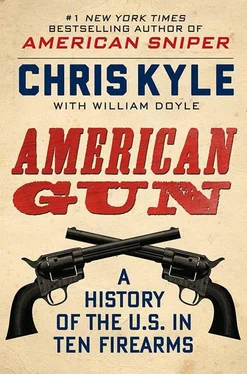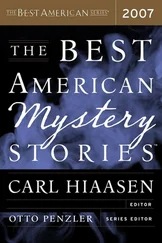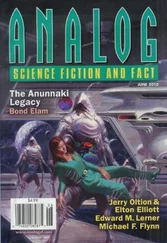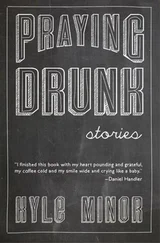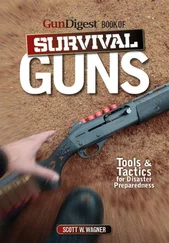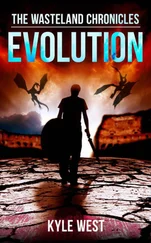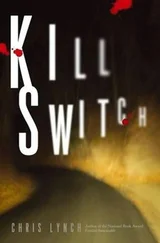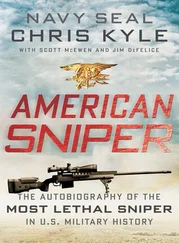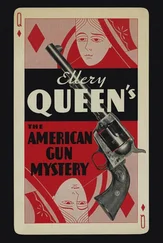Confronted by the police as they tried to escape, the pair easily outgunned the first officers on the scene, who had only 9mm handguns and a shotgun between them. While the criminals were cut off and trapped outside the bank, it took the police roughly forty-five minutes before they were finally able to kill them. In the meantime, eighteen officers were wounded out of the nearly three hundred involved.

Top: With my M4 on our first deployment in Iraq. Bottom: Hunting feral hogs in Texas with a favorite AR15.
The Kyle family
The two men’s rifles included an HK-91 with a drum magazine and AKMs. Their armor-piercing bullets were capable of slicing through the vests the police wore.
“It was a watershed,” says Mark Hanten, my SWAT commander friend. The shoot-out was studied by his and other police forces all across the country. Among the more obvious conclusions: the police needed to be better armed.
Automatic rifles were part of the solution. While SWAT teams were common by the 1990s, North Hollywood and incidents like it showed that the specialty units were not the only ones who need high-powered rifles. As Rich Emberlin, who’s worked both SWAT and high-level protection roles in the Dallas police department points out, the first guys on the scene are often the ones who have the best chance to contain a situation before it gets ugly.
I can attest to the fact that criminals are seriously armed these days. A while back, the Dallas police department allowed me to tag along when they served a warrant on some suspected bad guys. The weapons stash they had would have made a SEAL’s eyes water. In fact, it did—I couldn’t believe the range of handguns and rifles the criminals had massed. The confiscated weapons filled a large van.
Dallas has started a program to equip patrolmen with AR15 variants. Besides finding the money, one of their biggest problems is making sure that the officers have enough time to train—which means they have to worry about having enough officers to fill their patrol spots while they’re on the range. Out in San Diego, Mark’s department spent five thousand dollars on ammo alone when half the SWAT team trained with new AR15-style rifles.
About those new guns: I worked with Mark as he went about putting the new kits together. They’re Sig Sauer 516s with ten-inch barrels and some very nice optics. It is a great package for perimeter and containment work, as well as being compact enough for interior work. There were smiles all around the range when the team was done.
On the other hand, I don’t think anyone in the department will be sorry if they’re never used anywhere but the target range.
Whether they’re used in war or for keeping the peace, guns are just tools. And like any tool, the way they’re used reflects the society they’re part of. As times change, guns have evolved. If you don’t like guns, blame it on the society they’re part of.
One of the interesting things about the AR15 is its size. Next to the rifle we started this book with, the American long rifle, the modern AR15 combat rifle is small. There’s an advantage in that: it can also be handled by a wide range of people.
Back when our friend Sergeant Murphy was shooting officers out of their saddles, the Continental Army and the American militias were almost exclusively male. Now women are an important part of the military and law enforcement forces.
And so maybe it’s appropriate we end this little tour of the modern combat rifle with the story of Leigh Ann Hester
In civilian life, Leigh Ann Hester was a petite, twenty-three-year-old woman who helped manage a shoe store in Nashville, Tennessee. At 9 a.m. on Sunday, March 20, 2005, she was a U.S. Army sergeant with the 617th Military Police Company, Kentucky National Guard stationed in a combat zone in Iraq. She and her squad of eight men and another woman were patrolling a road south of Baghdad and just north of Salman Pak. As usual, she had her short-barreled M4 within easy reach inside her up-armored Humvee.

Artist James Deitz’s depiction of the events of March 20, 2005, in Salman Pak, Iraq. Sgt. Leigh Ann Hester—and her M4—is pictured in the foreground at bottom right.
U.S. National Guard (painting by James Deitz)
Suddenly, Hester heard gunshots and explosions ahead. The patrol sped up, reaching a convoy of thirty civilian supply trucks and tractor-trailers. The vehicles were being ambushed with intense small-arms fire from the side of the road. An unusually large force of insurgents had filled trenches along the highway and were firing at the trucks. Bullets were flying everywhere.
Staff Sergeant Timothy Nein, in the lead Humvee, saw the civilian trucks trying to scatter. “Flank ’em down the road!” hollered Nein to the rest of the squad. A moment later, a rocket-propelled grenade slammed into the top of his vehicle. Waves of rifle fire punched into the grill and side door as the Hummer ground to a halt.
The others stopped and began engaging the insurgents. The Humvees took multiple hits. In the third truck, all the soldiers except Specialist Jason Mike were wounded. Mike grabbed an M4 assault rifle and an M249 light machine gun and began firing in two different directions to push back the attackers.
Hester spotted a convoy of seven parked cars not far away. The enemy was planning a fast getaway—and more than likely a kidnapping as well. Nein, who was still fighting despite the hits his vehicle had taken, decided their best bet was to go on the offense. He took his rifle and started walking directly toward the enemy positions in the trenches and behind trees and piles of dirt.
Hester jumped from her Humvee to back him up. Carrying her M4 and attached grenade launcher, she ran up alongside Nein as he took cover behind a berm. Nein plugged an insurgent as he popped his head out from behind a tree. Hester zeroed in on a man with a machine gun. She put him in her sights and squeezed the trigger.
“It’s not like you see in the movies,” she said later on. “They don’t get shot and get blown back five feet. They just take a round and they collapse.”
Hester gunned down another insurgent, then she and Sergeant Nein jumped into a nearby drainage ditch to get a better angle on the enemy. They started working their way down, pushing the insurgents back, step by step, using rifle fire and a grenade from Hester’s launcher. When they started running low on ammo, Hester ran on back to her Humvee to get more. The firefight went on for more than thirty minutes until other U.S. forces arrived. The wounded were evacuated by helicopter, and the area was eventually secured. The Americans killed twenty-seven insurgents, wounded six, and took one prisoner. Hester personally killed at least three Iraqis with rifle and grenade fire from her M4. She received the first Silver Star given to a woman since World War II. Six other soldiers in her unit were decorated, including Specialist Jason Mike, Sergeant Timothy Nein, and Specialist Ashley Pullen.
Sergeant Hester “maneuvered her team through the kill zone into a flanking position where she assaulted a trench line with grenades and M203 rounds,” according to the Army citation that accompanied her Silver Star. “She then cleared two trenches with her squad leader where she engaged and eliminated three AIF [anti-Iraqi forces] with her M4 rifle. Her actions saved the lives of numerous convoy members.”
Читать дальше
